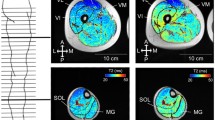Abstract.
We hypothesized that activation of the quadriceps femoris muscle group during eccentric exercise is related to the increase in magnitude of several markers of muscle injury that developed during the next week. Fourteen male subjects performed six to eight sets of five to ten repetitions of single-leg eccentric-only seated knee extension exercise. Magnetic resonance (MR) images were collected before and immediately after exercise and on days 2–4 and 6 after eccentric exercise. Changes in maximal voluntary contraction (MVC), perceived soreness, muscle volume and muscle transverse relaxation of water protons (T2) were determined for the quadriceps femoris muscle group each day. Changes in muscle volume and T2 were determined every day for each muscle [vastus lateralis (VL), vastus medialis (VM), vastus intermedius (VI), rectus femoris (RF)] of the quadriceps femoris group. Post-exercise T2 was greater than pre-exercise T2 (P<0.05) for all muscles. The acute ΔT2 (Post-Pre) was similar (P>0.05) among VL, VM, VI, and RF [5.5 (0.3) ms], suggesting that the four muscles were equally activated during eccentric exercise. In the week after eccentric exercise, subjects experienced delayed-onset muscle soreness (DOMS) and all muscles demonstrated a delayed increase in T2 above pre-exercise values (P<0.05), suggesting that muscle injury had occurred. For the quadriceps femoris muscle group, there was no correlation between acute ΔT2 and delayed (peak T2 during days 2, 3, 4, 6 minus pre-exercise T2) ΔT2 (r=0.04, P>0.05). Similar results were obtained when VL, VM, VI and RF were examined separately. Of the four muscles in quadriceps femoris, the biarticular RF experienced greater muscle injury [delayed ΔT2=15.2 (2.0) ms] compared to the three monoarticular vasti muscles [delayed ΔT2=7.7 (1.3) ms; P<0.05]. We propose that the disproportionate muscle injury to RF resulted from an ineffective transfer of torque from the knee to hip joint during seated eccentric knee extension exercise, thus causing RF to dissipate greater energy than normal. We conclude that in humans, muscle activation is not a unique determinant of muscle injury.
Similar content being viewed by others
Author information
Authors and Affiliations
Additional information
Electronic Publication
Rights and permissions
About this article
Cite this article
Prior, B.M., Jayaraman, R.C., Reid, R.W. et al. Biarticular and monoarticular muscle activation and injury in human quadriceps muscle. Eur J Appl Physiol 85, 185–190 (2001). https://doi.org/10.1007/s004210100434
Accepted:
Issue Date:
DOI: https://doi.org/10.1007/s004210100434




